-
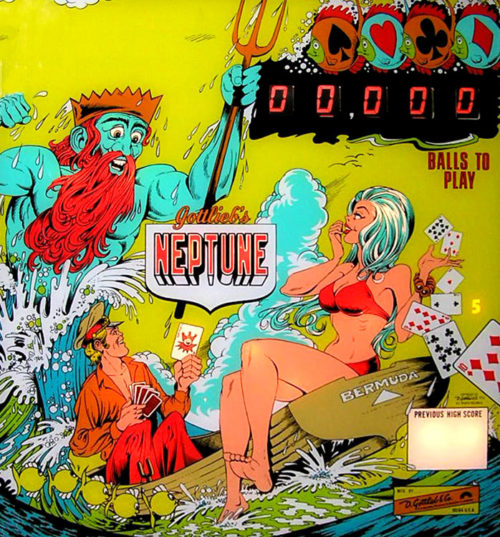 This rare add-a-ball game was released in April. It was designed by John Osbourne with artwork by Gordon Morison. A minimal total of 270 units were soldered together at the time. This is a small number for a pinball run. The replay version had a much larger production and the name of that game was Hit The Deck. As you can see from the backglass, Gottlieb tried to experiment with a score reel that was completely different in coloring. This was to attract attention to the game and attract quarters. The object of the game is to roll over the red number and/or black number sequence inherent in the game. If you are skillful enough to get the 9 to Ace sequence, some wow options will light up to score extra balls. A kickback feature is incorporated into the game in the upper-left area. This single-player game is challenging and a rare sight to see.
This rare add-a-ball game was released in April. It was designed by John Osbourne with artwork by Gordon Morison. A minimal total of 270 units were soldered together at the time. This is a small number for a pinball run. The replay version had a much larger production and the name of that game was Hit The Deck. As you can see from the backglass, Gottlieb tried to experiment with a score reel that was completely different in coloring. This was to attract attention to the game and attract quarters. The object of the game is to roll over the red number and/or black number sequence inherent in the game. If you are skillful enough to get the 9 to Ace sequence, some wow options will light up to score extra balls. A kickback feature is incorporated into the game in the upper-left area. This single-player game is challenging and a rare sight to see. -
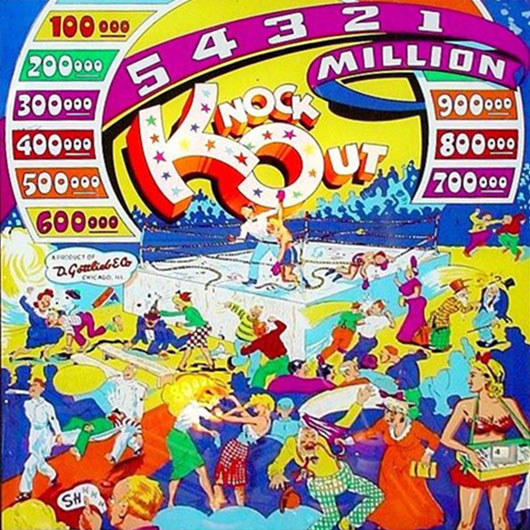 This game was produced in December of the year and designed by Harry Mabs with artwork by Roy Parker. 3,000 of these machines were made. The unique feature built into this machine is the animation unit in the top center of the play field. Two mechanical men are represented as boxers in a boxing match. Lights illuminate the bout when a knockout is scored by rolling over a “KO” rollover, a “KO” target, or completing bumpers 1 to 5. This game is one of the first examples of pinball animation. Another feature of the game is the pop-up bar at the bottom of the play field, preventing you from losing your ball in play for an extended period. Since the gap between the flippers is so massive, this addendum to the play field was installed to prolong the play period of the ball. A special feature is included in the game as well as a replay if 15 knockdowns are scored in one game and a replay for every knockdown scored thereafter.
This game was produced in December of the year and designed by Harry Mabs with artwork by Roy Parker. 3,000 of these machines were made. The unique feature built into this machine is the animation unit in the top center of the play field. Two mechanical men are represented as boxers in a boxing match. Lights illuminate the bout when a knockout is scored by rolling over a “KO” rollover, a “KO” target, or completing bumpers 1 to 5. This game is one of the first examples of pinball animation. Another feature of the game is the pop-up bar at the bottom of the play field, preventing you from losing your ball in play for an extended period. Since the gap between the flippers is so massive, this addendum to the play field was installed to prolong the play period of the ball. A special feature is included in the game as well as a replay if 15 knockdowns are scored in one game and a replay for every knockdown scored thereafter. -

-
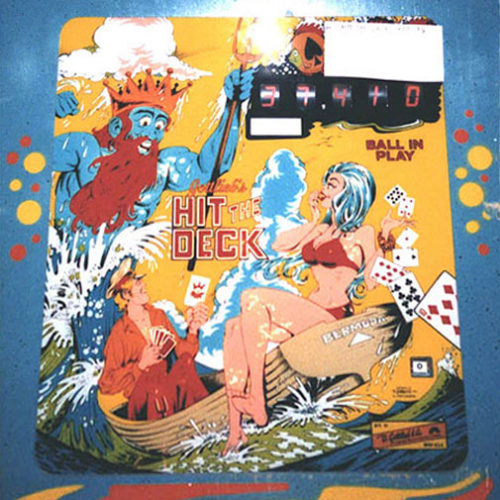
-
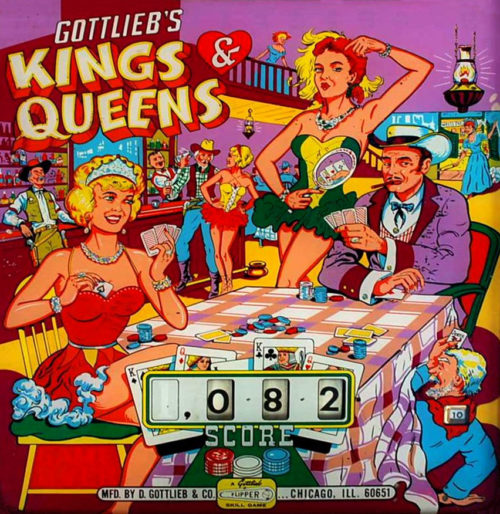 This game is a classic and is rated # 5 in collectible machines of the ‘60s. The game was created by Wayne Neyens with artwork by Roy Parker. Production run was 2,875 units. The main action in the game comes from the four in-line kickout holes set across the center playfield. The object of the machine is to hit a suit of four cards vertically under the kickout holes. If you get all four, a hole will randomly light up to score a free game (i.e., a special). The challenge here is to sink the ball in the kickout holes once a special is lit. All four holes can light up if you’re lucky enough to score all 16 cards. Finally, another special in the top rollover lanes randomly lights if you score just the four top cards on the pattern of cards. Score also was a factor as dropping balls in the kickout holes with many cards lit scored a lot of points very quickly.
This game is a classic and is rated # 5 in collectible machines of the ‘60s. The game was created by Wayne Neyens with artwork by Roy Parker. Production run was 2,875 units. The main action in the game comes from the four in-line kickout holes set across the center playfield. The object of the machine is to hit a suit of four cards vertically under the kickout holes. If you get all four, a hole will randomly light up to score a free game (i.e., a special). The challenge here is to sink the ball in the kickout holes once a special is lit. All four holes can light up if you’re lucky enough to score all 16 cards. Finally, another special in the top rollover lanes randomly lights if you score just the four top cards on the pattern of cards. Score also was a factor as dropping balls in the kickout holes with many cards lit scored a lot of points very quickly. -
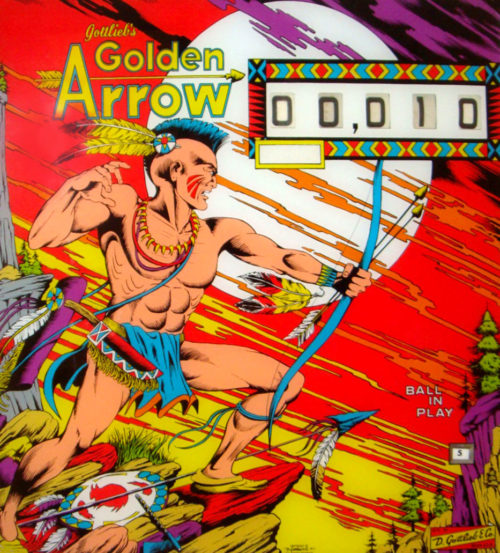 Here’s another example of a Gottlieb single-player mechanical game when all the other manufacturers during this period were developing solid-state computerized machines. Ed Krynski is the designer with Gordon Morison the artist of choice for this model, one of 1,530 machines made. The machine itself is a classic ’70s. Ten numbers is your goal here. You achieve these ten targets by hitting and rolling over the appropriate spots on the playfield. Hitting the spinner spots the numbered target the spinner stops on. If you’re lucky to complete the targets, the special lights up and advances through the ten numbers. Hitting the lighted number with “special” lit means more free time playing the game. Score for replays is your second goal. Nice artwork in a single player game, one of the last produced.
Here’s another example of a Gottlieb single-player mechanical game when all the other manufacturers during this period were developing solid-state computerized machines. Ed Krynski is the designer with Gordon Morison the artist of choice for this model, one of 1,530 machines made. The machine itself is a classic ’70s. Ten numbers is your goal here. You achieve these ten targets by hitting and rolling over the appropriate spots on the playfield. Hitting the spinner spots the numbered target the spinner stops on. If you’re lucky to complete the targets, the special lights up and advances through the ten numbers. Hitting the lighted number with “special” lit means more free time playing the game. Score for replays is your second goal. Nice artwork in a single player game, one of the last produced. -
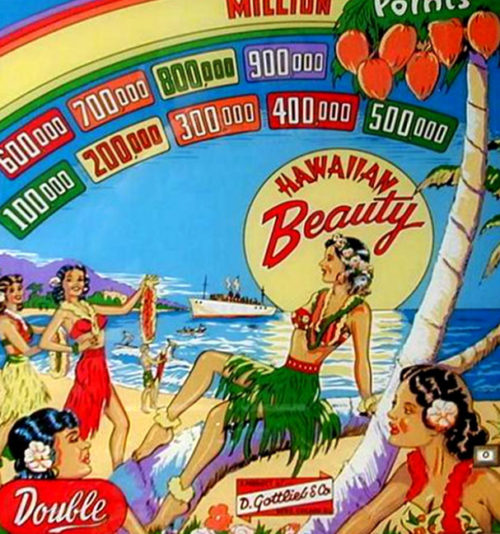 If there was a very pretty game manufactured in the ‘50s, this is it! Hawaiian Beauty was designed by Wayne Neyens with art package by none other than Roy Parker. 900 of these machines were screwed together in the Chicago factory. The game was initially called “Monkey Shine” but was later changed. This game also features the infamous “double” award. If you inset two nickels at the beginning of the game instead of the usual nickel, each won replay would score two games or double the winnings instead of one game. More coins in the coinbox was the hope of the arcade owners. The playfield is interesting in this game. Two blocked gobble holes at the top of the playfield would score 500,000 points and light lower side exit special lanes for replays. Hitting the 1-6 sequence at the top of the playfield would advance the rollovers to score 100,000 points if rolled over. Points as well as score won games.
If there was a very pretty game manufactured in the ‘50s, this is it! Hawaiian Beauty was designed by Wayne Neyens with art package by none other than Roy Parker. 900 of these machines were screwed together in the Chicago factory. The game was initially called “Monkey Shine” but was later changed. This game also features the infamous “double” award. If you inset two nickels at the beginning of the game instead of the usual nickel, each won replay would score two games or double the winnings instead of one game. More coins in the coinbox was the hope of the arcade owners. The playfield is interesting in this game. Two blocked gobble holes at the top of the playfield would score 500,000 points and light lower side exit special lanes for replays. Hitting the 1-6 sequence at the top of the playfield would advance the rollovers to score 100,000 points if rolled over. Points as well as score won games. -
 This game was an “add-a-ball” game; the replay version was called 2001. Production run was 490 units. This was the first game to feature the in-line drop targets in a bank of targets. It was designed by Ed Krynski with art by Gordon Morison. A total of 20 drop targets divided into 5 targets per color. Knocking down a full left set of targets or a right set of targets awarded extra balls to be played during your current game (versus free games as the replay version awarded). The targets would reset after each ball. Extra balls were also awarded if certain scores were achieved as set by the operator. Previous high scores could be posted by the arcade on the backglass as a contest to try and beat the high score. This game was near the end of single-player Gottieb games with the smaller flippers. All in all, a classic game requiring accuracy in your shots to gain extra balls!
This game was an “add-a-ball” game; the replay version was called 2001. Production run was 490 units. This was the first game to feature the in-line drop targets in a bank of targets. It was designed by Ed Krynski with art by Gordon Morison. A total of 20 drop targets divided into 5 targets per color. Knocking down a full left set of targets or a right set of targets awarded extra balls to be played during your current game (versus free games as the replay version awarded). The targets would reset after each ball. Extra balls were also awarded if certain scores were achieved as set by the operator. Previous high scores could be posted by the arcade on the backglass as a contest to try and beat the high score. This game was near the end of single-player Gottieb games with the smaller flippers. All in all, a classic game requiring accuracy in your shots to gain extra balls! -
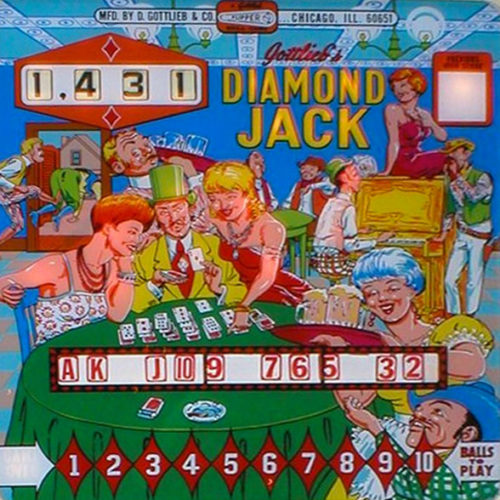
-
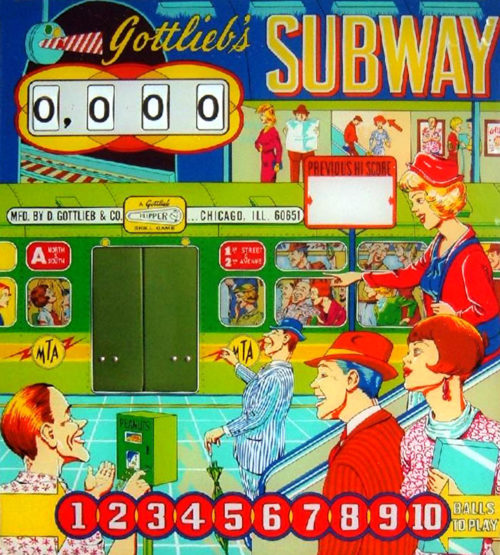 Gottlieb Subway arrived in October ’66. It was designed by the classic team of Ed Krynski and art by Gordon Morison. This add-a-ball version of the game closely resembled the replay version by the name of Crosstown. This wedgehead Gottlieb has an animated backglass. Every time 100 points are scored, the door of the subway opens, revealing passengers jammed together in a comical pose. The center target is where all the action is in the game. If you happened to match the two columns horizontally by advancing the columns by hitting various spots on the game and hit the center target, the award indicated would be given. Otherwise 10 points were awarded. This game was a tough game to play, as the opening between the flippers was rather large and a hit to the center target would regularly cost you a lost ball.
Gottlieb Subway arrived in October ’66. It was designed by the classic team of Ed Krynski and art by Gordon Morison. This add-a-ball version of the game closely resembled the replay version by the name of Crosstown. This wedgehead Gottlieb has an animated backglass. Every time 100 points are scored, the door of the subway opens, revealing passengers jammed together in a comical pose. The center target is where all the action is in the game. If you happened to match the two columns horizontally by advancing the columns by hitting various spots on the game and hit the center target, the award indicated would be given. Otherwise 10 points were awarded. This game was a tough game to play, as the opening between the flippers was rather large and a hit to the center target would regularly cost you a lost ball. -
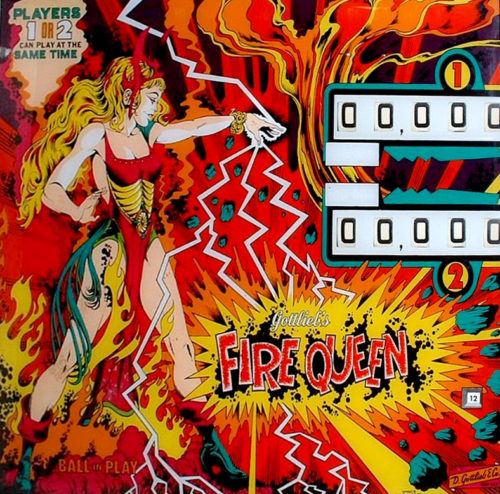 This replay game came out in December of the year with a four-player replay version (Vulcan) being released two months prior. 970 units were produced. Ed Krynski designed the game with Gordon Morison taking the credit for artwork. Two sets of drop targets in the firing range of the flippers make for a lot of accurate target shooting. Lighting all four green drop targets lights the extra ball target. The bonus value is doubled by hitting the bank of five drop targets. Making one to five numbered sequence lights two rollovers for a special as well as increases the white drop target value to three bonus advances. The kickout hole awards from 1,000 to 5,000 points dependent on the number of green drop targets hit at that moment in time. All in all, a nicely balanced game. Bonus is awarded upon draining the ball also.
This replay game came out in December of the year with a four-player replay version (Vulcan) being released two months prior. 970 units were produced. Ed Krynski designed the game with Gordon Morison taking the credit for artwork. Two sets of drop targets in the firing range of the flippers make for a lot of accurate target shooting. Lighting all four green drop targets lights the extra ball target. The bonus value is doubled by hitting the bank of five drop targets. Making one to five numbered sequence lights two rollovers for a special as well as increases the white drop target value to three bonus advances. The kickout hole awards from 1,000 to 5,000 points dependent on the number of green drop targets hit at that moment in time. All in all, a nicely balanced game. Bonus is awarded upon draining the ball also. -
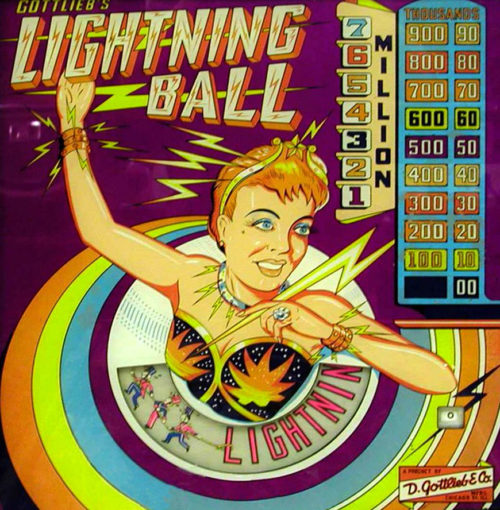 Wayne Neyens and Roy Parker again teamed up to create this pretty late-‘50s pin with an animated backglass. 950 units were made. The playfield has two gobble holes, which award 100,000 points for each rollover completed. If all six rollovers are made, a replay is awarded and the gobble holes are special holes. The main feature of the game is advancing the lightning ball backglass spelling. Each time you make the three colors on the playfield via rebound rubber or rollovers, the unit advances one step. If you are skillful enough to complete the lightning ball spellout, a replay is awarded, and each time you make the three colors to advance the letter, another replay is added. It’s not an easy task to complete. There’s always beating the game by scoring or matching. This game was somewhat retro as it has backglass light scoring, since Gottlieb already used reel scoring.
Wayne Neyens and Roy Parker again teamed up to create this pretty late-‘50s pin with an animated backglass. 950 units were made. The playfield has two gobble holes, which award 100,000 points for each rollover completed. If all six rollovers are made, a replay is awarded and the gobble holes are special holes. The main feature of the game is advancing the lightning ball backglass spelling. Each time you make the three colors on the playfield via rebound rubber or rollovers, the unit advances one step. If you are skillful enough to complete the lightning ball spellout, a replay is awarded, and each time you make the three colors to advance the letter, another replay is added. It’s not an easy task to complete. There’s always beating the game by scoring or matching. This game was somewhat retro as it has backglass light scoring, since Gottlieb already used reel scoring.